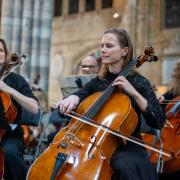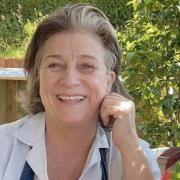An interest in the unconscious mind and exploration of his own sexuality lies behind the creative practice of Devon-born artist Wilfred Avery. A new exhibition showcases a fascinating and never before seen collection of his work
Wilfred Avery (1926-2016) only really tackled two subjects in his career: landscape and the male body. An investigation into both developed from an increasing interest in the unconscious mind and an exploration (and acceptance) of his own sexuality. By the end of his long life - one led with a rare and intense creative focus - he had unified these two chosen subjects into one compelling whole.
Wilfred and his twin brother Sam were born on April 24, 1926 on the kitchen floor of the New Inn, the South Molton pub managed by his parents Sidney Avery and Edith Lock.

They had a particularly bucolic upbringing, spending much of their childhoods exploring the hills and coastline surrounding their home.
This salt-licked landscape got right under Wilfred’s skin and never really left. Threading through the entirety of his 60-year career; wherever he was living, and whatever he was painting, Wilfred found himself consistently painting home.
As a young man, Wilfred’s developing interest in modern art was reinforced by a meeting with Paul Nash, who encouraged him to look to France rather than America for inspiration. Though brief, this conversation would shape his entire career, instilling a deep appreciation for the work of Cezanne, Picasso and Braque. Much later in 1963, (and with Nash’s advice still in mind), he would spend a year there, painting in the Paris ateliers and attending classes taught by Braque and Giacometti.

Wilfred moved to London in 1952. It was certainly the right time to move to the capital as an artist. Experimental commercial galleries had begun to crop up all over the post-war city, and Wilfred showed some of his earliest work in two of its most important, Helen Lessore’s Beaux Arts Gallery and Victor Musgrave’s Gallery One. But 1950s London was a city of harsh contradiction, filled as much with vibrant creativity as it was with social and governmental intolerance.
Despite the slow creep towards equality put into place by the 1957 Wolfenden Report, homophobia and sexual repression continued to loom large over Britain. Wilfred never defined himself through his sexuality, but dismissing the suggestions of queer life in his 1950s works, made and exhibited within the context of such an inhospitable period in British history, would be a crucial error in interpretation.
His quietly undressing young men provide an intimate window into queer domestic life. And by painting the queer body within the domestic interior, Wilfred was doing something radical; subverting the traditional concept of home and drawing attention to the fact that whatever one’s sexual orientation, domestic life is inherently the same.

In the late 1950s Wilfred turned from the figure and looked instead to landscape. The paintings were close, Cubist inspired and glowing scenes; hills and trees jostling for space within the frame. Rather than London scenes, they were landscapes sourced instead by turning inwards; views of Wilfred’s Devon childhood and early adulthood in Exmouth.
‘My sense of place does not lie here.’ he wrote, in 1967, ‘My place is the hills and the valley turning into the sea, the sea running into the land, the rocks running under the sea and running onto the curve of the horizon.’
This quasi-religious attitude to landscape remained strong throughout his career. Wilfred’s ongoing practice was imbued with a generalised spirituality, one which would, from the 1960s onwards, morph into a fixation with the subconscious mind, and the works of Carl Jung.

This new period of his work can be summed up in three words: the unpredictable image, an expression the artist used to describe the end result of a creative process increasingly influenced by the unconscious mind. Wilfred’s process became one of discovery rather than predetermination, a new attitude that can best be encapsulated in one wonderfully light-hearted comment of his, ‘the joy of painting is to be surprised!' In a similar sway, when collaging, he would work consistently upside-down, in an attempt to dissociate from whatever non-abstract image was on the page.
Fed up with the London artworld, in 1979 Wilfred left the city and relocated back to Devon, first to Ashburton and then Budleigh Salterton, reigniting his interest in landscape. This time, however, he began to entwine his figures into the land. His organic and shifting fusions pulsate with life and energy; erotic configurations land-locked in passionate embraces.
It was from this point that he managed to fully merge those two pivotal subjects of his — landscape and the male body. They are strange and morphing islands, throbbing with energy and life. An ever-kinetic, rhythmic quality gives the sense that each work has its own pulse. Neither remote nor isolated, each work is alive, embodied.

Now garnering long-awaited and well-deserved interest by public institutions and private collectors alike, Wilfred’s work can now be found in institutions including museums Sheffield, RAMM Exeter, The Hepworth Wakefield and The Towner Eastbourne.
Wilfred Avery and the Unpredictable Image includes a selection of distinctive works from national institutions as well as private collections and studio works never seen before by the public, and opened alongside the launch of a monograph of the same name, the first written about the artist.
The exhibition runs at the Museum of Barnstaple and North Devon until January 27 2024.




























